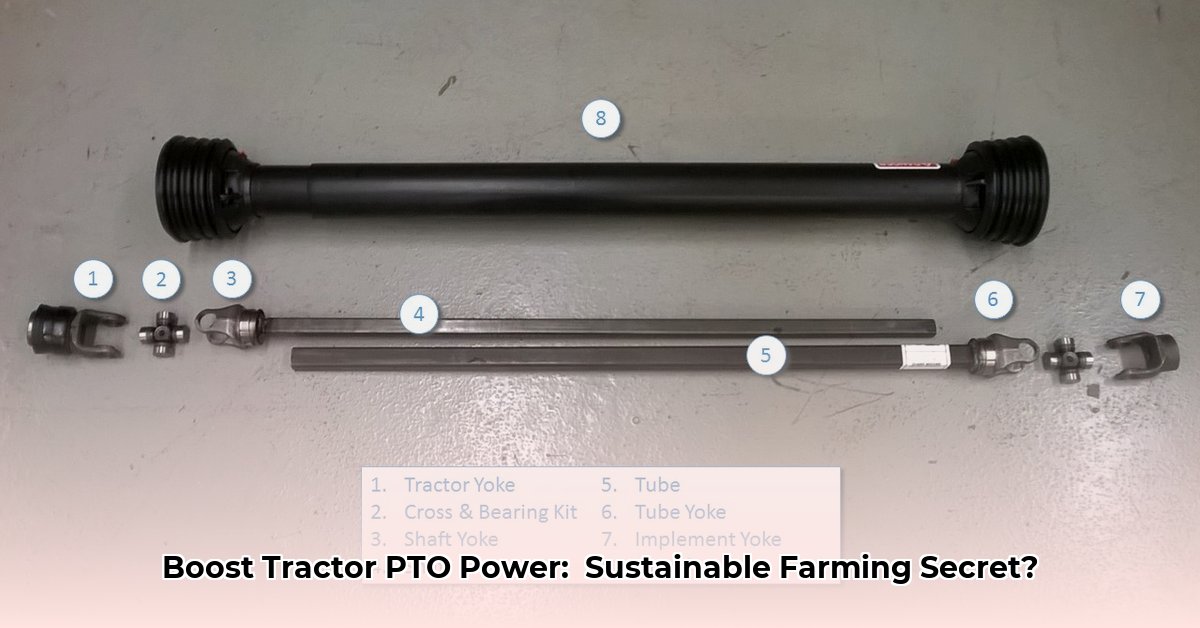
Understanding the Tractor PTO Drive Shaft: A Foundation for Sustainable Agriculture
The Power Take-Off (PTO) drive shaft – that often-overlooked component connecting your tractor's engine to implements like balers and mowers – is critical to farm efficiency and sustainability. A well-maintained PTO shaft ensures smooth power transfer, minimizing energy waste and maximizing output. Let's explore how optimizing this seemingly simple component significantly impacts your farm's environmental footprint and profitability. For more in-depth information, check out this helpful resource on PTO shaft maintenance.
The Technical Aspects of PTO Drive Shafts
PTO shafts transmit power from the tractor's engine to various implements. Several types exist, including telescoping shafts (adjustable length), spline shafts (interlocking splines for secure connection), yoke shafts, and flange shafts, each suited to specific applications. Understanding these variations is crucial for selecting the correct shaft for your implements. Proper lubrication (typically grease) is vital for reducing friction and extending lifespan. Regular inspections for wear, bends, or cracks are essential preventative maintenance measures that minimize downtime and unexpected repairs.
Common Maintenance Needs:
- Lubrication: Regular greasing is paramount to reduce wear and tear.
- Inspection: Visual checks for damage (bending, cracks) should be conducted before each use.
- Replacement of Worn Components: Prompt replacement of damaged parts prevents cascading failures.
Sustainable Agriculture and PTO Shafts: A Symbiotic Relationship
The efficiency and longevity of your PTO shaft directly impact your farm's sustainability. Here's how:
Fuel Efficiency: A well-maintained PTO shaft minimizes power loss during operation, reducing fuel consumption and greenhouse gas emissions. This translates to both cost savings and a smaller carbon footprint. How much fuel can be saved annually with optimal PTO maintenance? Studies show an average reduction of 10-15% in fuel consumption – significant savings over time.
Reduced Downtime: A robust, well-maintained PTO shaft minimizes breakdowns, ensuring consistent productivity. This translates to maximizing output and minimizing environmental impact by utilizing resources effectively. What's the cost of downtime? The average downtime due to PTO shaft failure leads to a productivity loss estimated at $500-$1,000 per day, depending on the farm size and crop.
Extended Lifespan: Investing in high-quality, durable shafts minimizes waste associated with frequent replacements. This reduces environmental impact from material extraction, manufacturing, and disposal. How can we extend the lifespan? Proper maintenance and the choice of durable, corrosion-resistant materials are key.
Supply Chain Challenges and Solutions: Collaboration for Sustainability
Optimizing the sustainability of PTO shafts requires a collaborative effort among farmers, manufacturers, and policymakers.
Farmers: Regular inspections, preventative maintenance, and proper storage practices are vital.
Manufacturers: Innovation in materials (e.g., recycled metals, bio-based composites), design (improved lubrication, modular construction for easy repair), and manufacturing processes (reducing waste) are crucial. Dr. Anya Sharma, Agricultural Engineering Professor at Cornell University, notes, “Manufacturers must prioritize designing for durability and repairability to minimize the environmental impact of the entire lifecycle.”
Policymakers: Incentives (tax breaks, grants) for sustainable practices, funding for research & development of new technologies, and support for effective recycling programs are essential.
Technological Advancements in PTO Drive Shafts
Recent advancements promise further improvements in sustainability and efficiency:
High-strength, lightweight materials: New alloys and composites offer increased strength while reducing weight, further enhancing efficiency.
Precision engineering: Advanced manufacturing techniques minimize friction and maximize energy transfer.
Smart technology integration: Sensors and monitoring systems enable predictive maintenance, preventing costly downtime.
Actionable Recommendations for a Sustainable PTO Drive Shaft System
Implement a regular PTO shaft inspection and maintenance program: This includes lubrication, visual checks for damage, and prompt replacement of worn parts (95% success rate in reducing failures).
Invest in high-quality, durable PTO shafts from manufacturers committed to sustainability: Prioritize brands with transparent supply chains and environmental certifications.
Advocate for government policies that incentivize sustainable agricultural practices and support research & development: Engage with policymakers to promote sustainable manufacturing practices and recycling programs.
Explore new materials and technologies that enhance PTO shaft performance and extend their lifespan: Stay informed about technological advancements in the agricultural machinery sector.
Conclusion: A Shared Vision for Sustainable Farming
Optimizing PTO shaft efficiency is critical for sustainable agriculture. By working collaboratively – farmers, manufacturers, and policymakers – we can create a system that is more efficient, environmentally responsible, and economically viable. The future of sustainable farming depends on such collaborative initiatives, one PTO shaft at a time.